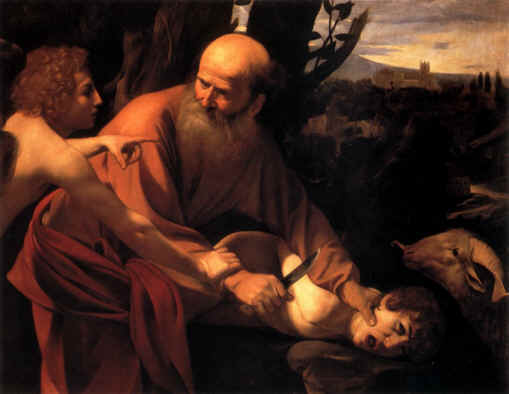
Carravaggio, Abraham and Isaac
Lecture 6. November 14, 1947
There are three periods to the Hebrew religion: Pre-prophetic, prophetic, post-prophetic or priestly.
The pre-prophetic is a mixed cult. The pre-exilic prophets—Amos, Hosea, Micah, Isaiah, Jeremiah—represent a spiritual awakening in history. It might be part of the general movement of Zoroaster whose teaching affected the life of the Hebrews. The prophetic follows the worship of Jehovah. The post-prophetic (priestly) is the legalizing of Jehovah. This period is Judaism, the founding of the second temple, the synagogue, the Pharisees, and an organized cult.
Amos is one of the earliest prophets. Genesis and Kings II have four or five main documents showing the people affected by prophetic teaching. There is no “pure” pre-prophetic phase. First there was YHVH (Yahveh) which became Jehovah, the tribal, ancestral God of the Hebrews. This is what the prophets preached. The pre-prophetic religion which the prophets attacked as not “pure”: that is, it had a mixture of other gods. The mixing of cults was wrong, and the wrongness hinged on the ritual and the ceremony.
REVELATION IS CONSOLIDATED REALITY
The prophets emphasized doctrine and teaching. Judaism, or the priestly period, was the synthesis of religious doctrine with the prophetic teaching. The prophets were actuated by a feeling of moral evil on the part of any mixed cult.
WHAT CAUSED THIS FEELING?
Palestine is an agricultural country, a land flowing with milk and honey. Its chief products are grain, wine, oil. Before that, the people were nomads with their herds. The tradition is that the Hebrews were not always farmers. They learned it from the surrounding people. For the nomads, the sun is a destroyer and the moon is a friend. The word for moon is halle = hallelujah. The nomads were not interested in rain and nature. Abel is the idealized shepherd but the real shepherd is descended from Cain, whose name means smith, artificer. Cain founded the first city.
Reflected in this nomad-farmer background we see the steady expansion of civilization from farm to city. Every time this happens, the land of the nomads has been cut off—by barbarians, Tartars, Huns, and so on, which inspires panic. We see it in American western stories of the ranger menaced by the city slicker.
Abel’s sacrifice was accepted, but the bloodless one of Cain was not accepted. There is the paradox of the killing of Abel. It is the death of humankind and marks war as a state of existence, springing from Cain, the artificer of the ploughshare and the sword.
In the story of Isaac and Abraham (Chapter 22), we see God accepting animal sacrifice still, but he doesn’t like human sacrifice. The Canaanites practised it, and the characteristic of the Kings Who Went Wrong is that they practised the rites of the kings about them, human sacrifice. Ahaz was influenced by the Israelites in this respect.
Connected with sacrifice is the idea of transference of power. The king is the reservoir of force, like a charge of electricity. The more he is a reservoir of power the more fragile he becomes, the more enmeshed he is in taboos. When he is killed you’ll feel something pretty terrific. This electric energy must go into the tribe, so they drink his blood and eat his flesh.
Human sacrifice is also a communion. The body of the king becomes the body of the tribe; the social body is the incarnate leader. The king’s successor gets his share; he is smeared with fat, the anointed one. In the art form of tragedy, the king is killed on stage and his body and blood pass into the audience. That is catharsis.
However, a society so organized is not that stable. Some modifications came in with the idea of substitution, his own son or his wife. The king must die at the height of his power, about age thirty. The substitute king can be a captive from another tribe who may be made mock king for a while. It varies in tribes; he can be the buffoon or like the king. Christ has both the triumphal ride and the mockery. Sometimes it was the sacrifice of the king’s son or mock-son. For the Canaanites, it was the son.
To a farming community, the king is solidarity. This is different from the solidarity of a nomad tribe. The centre of gravity in the farming community is in the land and its fertility, the harvest. Their king would be the harvest and the vintage, the bread and the wine. The God of farmland incorporates the forces of nature and the fertility of the crops. He sums up literally the social solidarity which is the wine and grain as his blood and body. It is not symbolic here. The tribe still has the leader who is their blood and body.
Human sacrifice is not a bribe in this sense, but a communion with a god incarnate in a man. The original victim was a god-man; then came a substitute. The victim of the sacrifice would have more than human quality as the son of the god. There are rituals that are bribery to some demon in the sky. But the true religious impulse doesn’t think of God as separate but as incarnate in a man.
